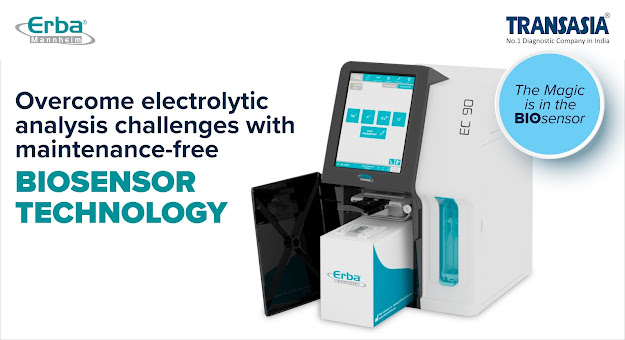Overcome electrolytic analysis challenges with maintenance-free biosensor technology
Find out how to increase the accuracy and reduce the processing time of
your routine electrolyte
Electrolyte analyzers are routinely used in medical diagnostics to examine
physiological conditions within the body. Hospitals and clinical
laboratories, as well as treatment sites, rely on electrolyte analyzers to
measure the concentration of different ions in the blood, providing important
information about the body's electrolyte balance that can be used to detect
metabolic imbalances, assess kidney and heart disease and contribute to the
early detection of human diseases. However, despite their widespread use,
electrolyte analyzers operating with traditional electrode technology are
subject to a multitude of challenges, with the need for periodic replacement of
electrodes, in particular.
In this interview, we speak with Sourav Saha, Product Manager – Critical
Care, to learn more about the issues facing clinical labs performing
electrolyte analysis and how Erba EC 90, state-of-the-art
electrolyte analyzer can help overcome the problem. Sourav also provides top
tips on how to increase the success of electrolyte testing.
Why is it important to test for electrolytes?
Electrolytes keep our body fluids in a well-regulated balance, including
heart rate, muscle contraction, and brain function. Doctors order
electrolyte tests as part of regular health checkups to help diagnose medical
conditions, as well as to track the progress of specific medications,
particularly diuretics or angiotensin-converting enzyme (ACE) inhibitors, which
can create metabolic imbalances.
What challenges does clinical laboratories currently face with regard to
these analyses?
In the last 20 years, electrolyte analysis in clinical laboratories
using biological samples including serum, whole blood, urine, and others, has
been based mainly on electrochemical measurements using ion-selective
electrodes. Unfortunately, these electrodes require periodic maintenance
and can give erroneous results if not replaced frequently, which in turn
disrupts workflows and can be costly for laboratories. As a result, this
can increase hands-on time for clinicians and, more importantly, overall wait
time for patients.
How does the new EC 90 ISE analyzer address these challenges?
In an ideal world, clinicians and medical professionals would have a
stable analyzer that could be used flawlessly in everyday life. The EC 90
is a next-generation electrolyte analyzer that combines new maintenance-free
biosensor technology with an easy-to-use interface, advanced data management,
and excellent accuracy.
The EC 90 ISE analyzer's replaceable polymer sensor cartridge together
with its long life make this instrument a clinician's dream. The analyzer
is very easy to use and its built-in software helps correct any of the easy
mistakes made by traditional electrolytic analyzers.
Who is the system designed for?
The EC 90 is a compact analyzer that fits into any clinical laboratory,
and is capable of measuring the concentrations of free sodium (Na + ),
potassium (K + ), chloride (Cl - ),
and calcium ions (iCa2 + ) in the extracellular phase of
water from many different sample types.
The “all-in-one [all in one]” cartridges fit any size laboratory since
the cartridges integrate the reagent pack with the biosensor and are available
in three different kit sizes, small, medium and large, capable of performing
500, 1,000 and 3,000 sample measurements respectively with a three-month shelf
life on board.
Do you have any top tips for achieving success with this system?
The EC 90 performs automatic 1 and 2 point calibrations, monitors slopes
and provides advanced error signaling. It is very simple to operate with
minimal maintenance. The key, as with any analytical laboratory
instrument, is to run any QC regularly and review the data.
Fortunately, the analyzer's built-in software keeps a complete record
and can review Westgard QC rules and Levey-Jennings plots.
What are your hopes for electrolytic analysis in the future?
I would like to see the menu of measurement parameters expand and
provide additional electrolytes, eg magnesium, which can also be used in
combination with other biochemical tests and advanced algorithms (AI) to
improve early diagnosis and monitoring. Results from these biomarkers,
used in combination with other clinical data and symptoms, will add more
sensitivity and specificity to the assessment of upcoming physiological
conditions.




Comments
Post a Comment